Modelling the Impacts of Climate Change on Soybeans Water Use and Yields in Ogun-Ona River Basin, Nigeria
Abstract
1. Introduction
- (1)
- Estimate the seasonal CWR, yield and CWP of soybean during the baseline period (1986–2015) within the study area based on different soil textures.
- (2)
- Simulate the future seasonal CWR, yield and CWP of soybean for various soil textures under different climate change scenarios (2021–2099).
- (3)
- Compare the future seasonal CWR, yield and CWP of soybean for various soil textures to the baseline period under different climate change scenarios.
2. Materials and Methods
2.1. The Study Area
2.2. AquaCrop
- (1)
- Process-based crop models such as AquaCrop are superior to the statistical crop models especially in the assessment of the impact of climate change on crop growth, yields, and water requirements [10].
- (2)
- (3)
- AquaCrop has been widely used and validated in various climatic conditions for the assessment of climate change impacts on crop growth, development and water requirements with reliable outputs.
- (4)
2.2.1. Evapotranspiration, Crop Yield and Water Productivity
2.2.2. Soil Water Balance
2.3. Data Collection
2.3.1. Climate Data
2.3.2. Soil Data
2.3.3. Crop Data
2.3.4. Future Climate Projections
2.4. Performance Evaluation and Bias Correction of Future Climate Model
2.5. Calibration and Validation of AquaCrop
3. Results
3.1. Temporal Distribution of CWR, Yield and CWP in the Past Decades
3.1.1. Temporal Distribution of Seasonal Crop Water Requirements (CWR)
3.1.2. Temporal Distribution of Crop Yield
3.1.3. Temporal Distribution of Crop Water Productivity (CWP)
3.2. Future Changes in Climatic Parameters, CWR, Yield and CWP under Different Climate Change Scenarios
3.2.1. Future Seasonal Crop Water Requirements (CWR)
3.2.2. Future Crop Yields
3.2.3. Future Crop Water Productivity (CWP)
3.3. Temporal Changes in Future Seasonal CWR, Yield and CWP under Different Climate Change Scenarios for Different Soil Textures
3.3.1. Changes in Future Seasonal Crop Water Requirements (CWR)
3.3.2. Changes in Future Seasonal Yield
3.3.3. Changes in Future Crop Water Productivity (CWP)
3.4. Planting Dates and Length of Growing Seasons
4. Discussion
4.1. Historical Period
4.2. Future Periods
5. Conclusions
Author Contributions
Funding
Acknowledgments
Conflicts of Interest
Appendix A
| Month | Temperature (°C) | Humidity (%) | Wind Speed (km/Day) | Solar Radiation (MJ/m2/day) | Rainfall (mm/Month) | ||
|---|---|---|---|---|---|---|---|
| Ave | Min | Max | |||||
| January | 27.01 | 20.99 | 33.03 | 61.79 | 73.86 | 14.27 | 5.27 |
| February | 28.47 | 22.14 | 34.79 | 61.80 | 93.85 | 16.30 | 31.25 |
| March | 28.76 | 23.17 | 34.35 | 68.61 | 103.97 | 17.04 | 73.31 |
| April | 27.99 | 23.08 | 32.90 | 75.57 | 98.31 | 16.75 | 127.17 |
| May | 27.03 | 22.51 | 31.55 | 78.28 | 85.06 | 16.72 | 148.83 |
| June | 26.01 | 21.97 | 30.06 | 80.61 | 80.27 | 15.44 | 201.26 |
| July | 25.07 | 21.83 | 28.31 | 83.32 | 82.03 | 12.51 | 195.99 |
| August | 24.69 | 21.63 | 27.74 | 84.49 | 77.62 | 11.32 | 121.87 |
| September | 25.32 | 21.61 | 29.03 | 82.02 | 68.77 | 13.62 | 232.17 |
| October | 26.09 | 22.01 | 30.16 | 80.40 | 58.94 | 15.11 | 178.58 |
| November | 27.22 | 22.40 | 32.05 | 72.68 | 58.88 | 15.68 | 23.20 |
| December | 26.79 | 21.07 | 32.50 | 66.65 | 62.71 | 14.39 | 6.77 |
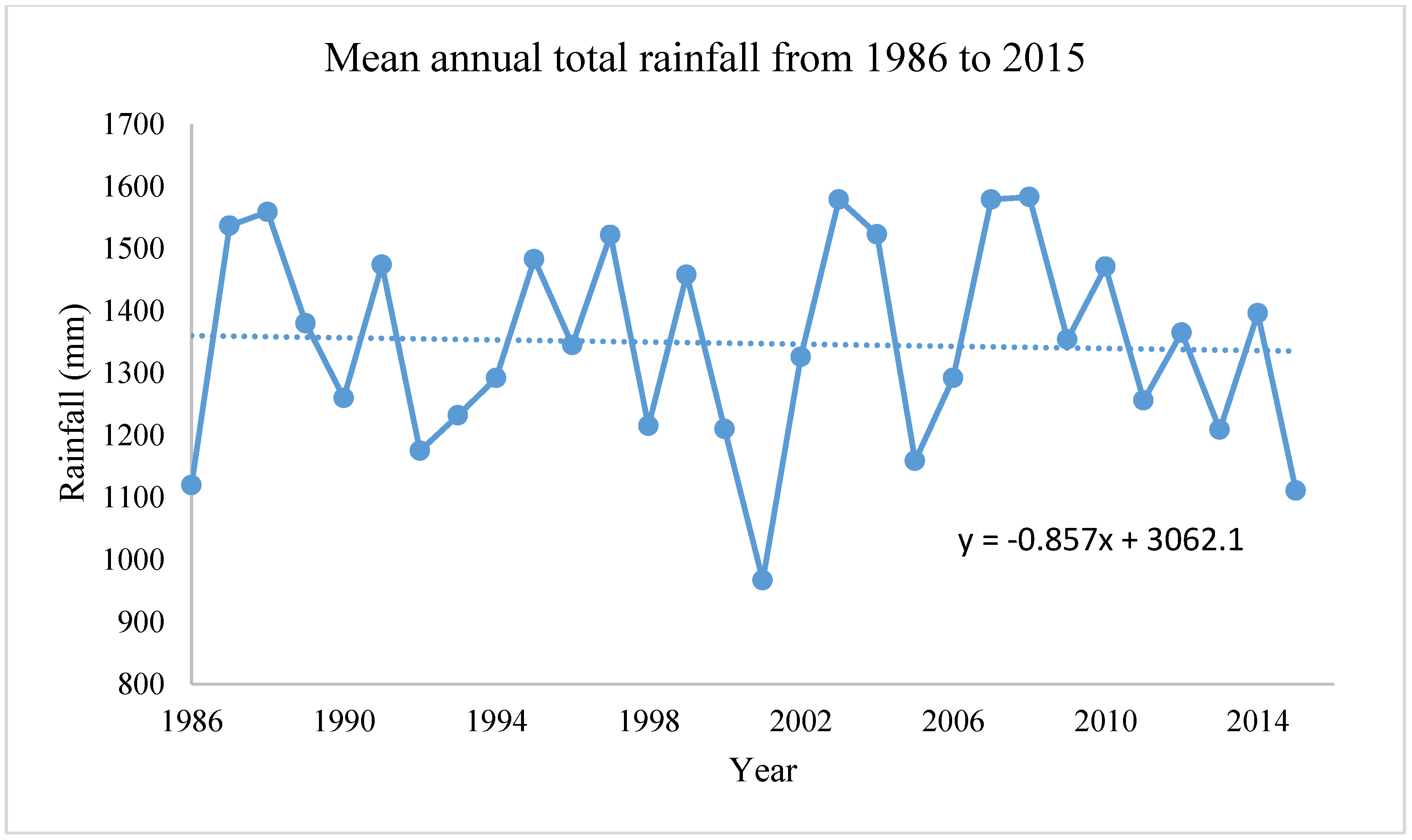
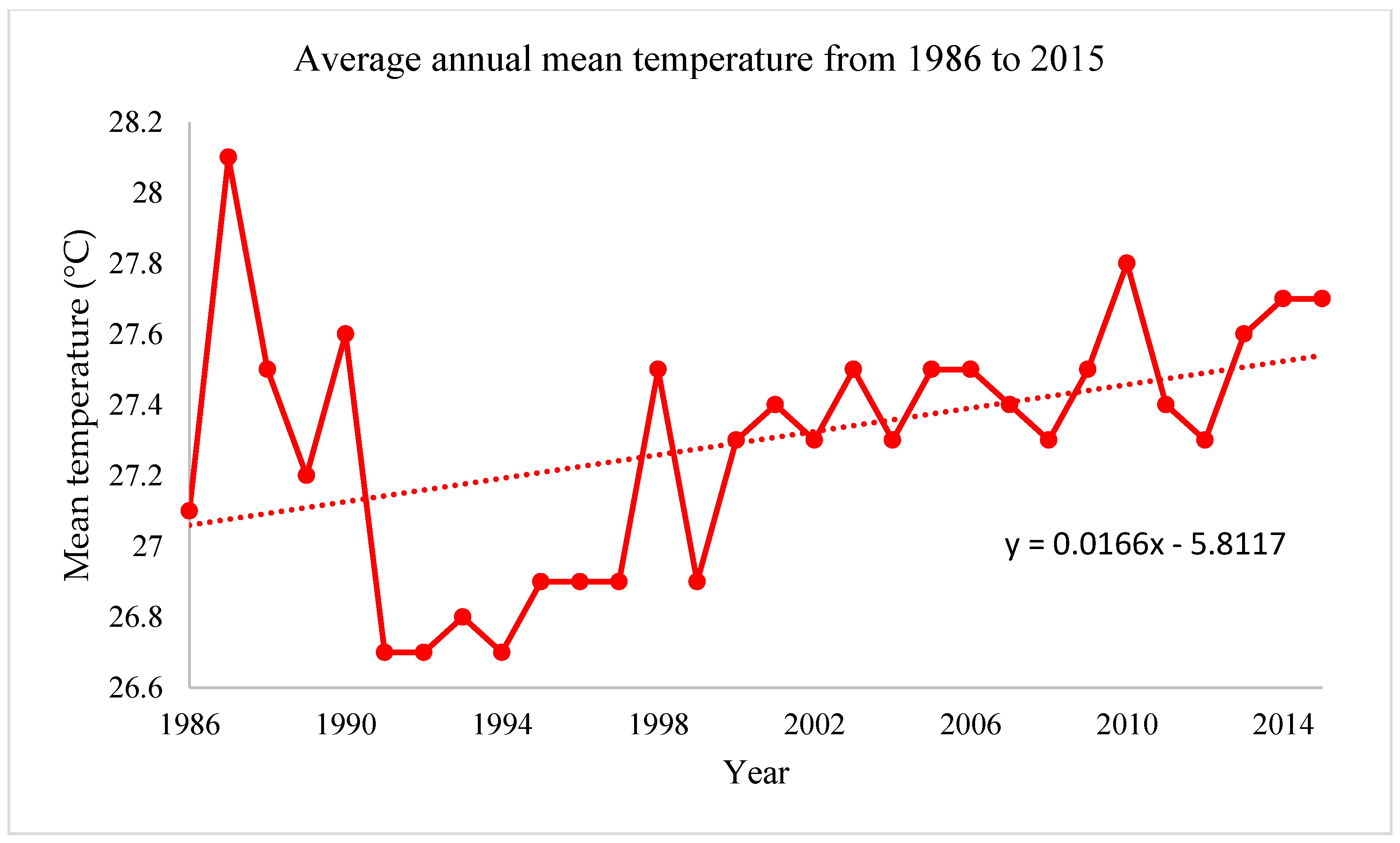
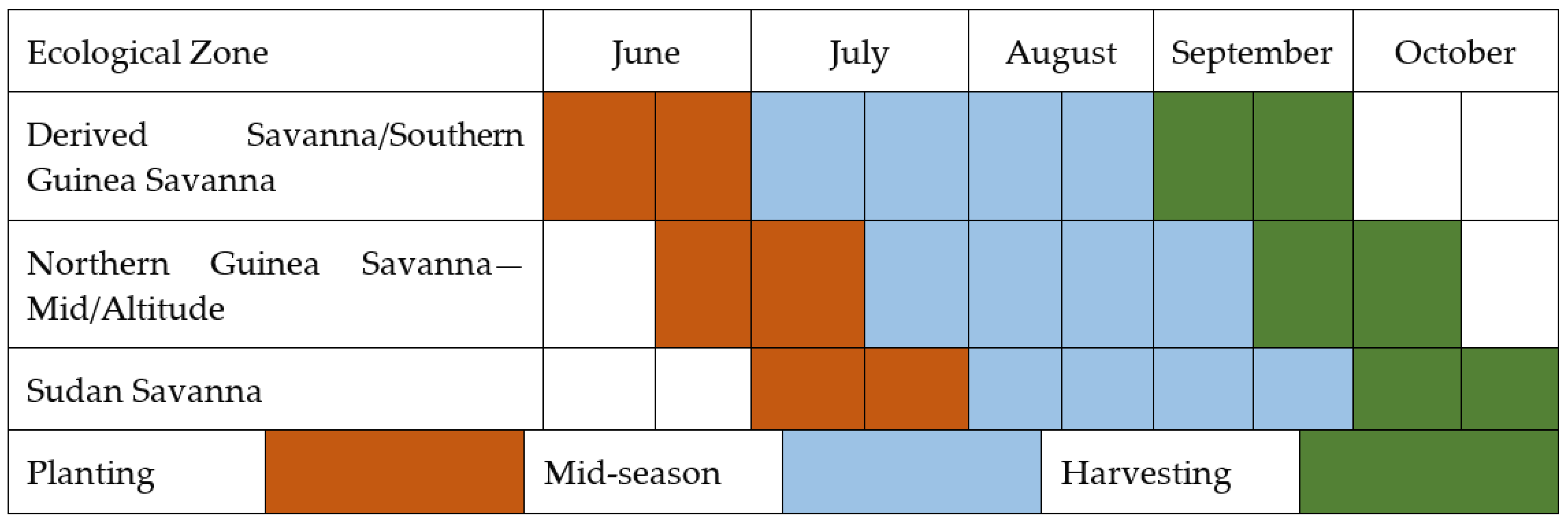
| Parameters | Unit | Soybean |
|---|---|---|
| Plant population | Plants/ha | 352,000 |
| Initial canopy cover | % of canopy cover | 0.40 |
| Maximum canopy cover | % of canopy cover | 90 |
| Days from planting to emergence | GDD (Day) | 105 (7) |
| Days from planting to maximum canopy cover | GDD (Day) | 1485 (99) |
| Days from planting to senescence | GDD (Day) | 1725 (115) |
| Days from planting to maturity | GDD (Day) | 1800 (120) |
| Days from planting to flowering | GDD (Day) | 607 (45) |
| Days from planting to maximum rooting depth | GDD (Day) | 1635 (109) |
| Length building up to HI | GDD (Day) | 510 (34) |
| Duration of flowering | GDD (Day) | 420 (28) |
| Maximum effective rooting depth | m | 1.6 |
| Normalized water productivity for climate and CO2 | g/m2 | 15.0 |
| Soil fertility stress | - | moderate |
| Sink strength under elevated CO2 | % | 50 |
| Reference harvest index | % | 40 |
| Year | Soil Texture | Observation (t/ha) | Simulation (t/ha) | R2 | RMSE (t/ha) | MAE (t/ha) | NSE |
|---|---|---|---|---|---|---|---|
| 2015 | Loamy sand | 2.79 | 2.81 | 0.99 | 0.98 | ||
| Sandy clay loam | 2.62 | 2.64 | 0.017 | 0.016 | |||
| Sandy loam | 3.06 | 3.07 | |||||
| 2014 | Loamy sand | 2.94 | 2.94 | ||||
| Sandy clay loam | 2.88 | 2.92 | 0.96 | 0.056 | 0.003 | ||
| Sandy loam | 3.10 | 3.19 | |||||
| 2013 | Loamy sand | 2.27 | 2.31 | ||||
| Sandy clay loam | 2.06 | 2.00 | 0.98 | 0.043 | 0.002 | ||
| Sandy loam | 2.54 | 2.56 | |||||
| 2012 | Loamy sand | 2.57 | 2.60 | ||||
| Sandy clay loam | 2.59 | 2.57 | 0.99 | 0.027 | 0.027 | ||
| Sandy loam | 2.86 | 2.89 |
References
- Baarsch, F.; Granadillos, J.R.; Hare, W.; Knaus, M.; Krapp, M.; Schaeffer, M.; Lotze-Campen, H. The impact of climate change on incomes and convergence in Africa. World Dev. 2020, 126, 104699. [Google Scholar] [CrossRef]
- Besada, H.; Werner, K. An assessment of the effects of Africa’s water crisis on food security and management. Int. J. Water Resour. Dev. 2015, 31, 120–133. [Google Scholar] [CrossRef]
- Sylla, M.B.; Nikiema, P.M.; Gibba, P.; Kebe, I.; Klutse, N.A.B. Climate change over West Africa: Recent trends and future projections. Adapt. Clim. Change Var. Rural West Afr. 2016, 25–40. [Google Scholar] [CrossRef]
- FAO. The State of the World’s Land and Water Resources for Food and Agriculture: Managing Systems at Risk; Routledge: London, UK, 2016. [Google Scholar] [CrossRef]
- FAO. Water for Sustainable Food and Agriculture. In A Report Produced for the G20 Presidency of Germany; FAO: Rome, Italy, 2017. [Google Scholar]
- Rahman, M.A.; Haq, M.E.; Anjum, N. Potential crop water requirements of dry season boro rice under climate change in north-east hydrological region of Bangladesh. Agric. Eng. Int. CIGR J. 2019, 21, 1–13. [Google Scholar]
- Boonwichai, S.; Shrestha, S.; Babel, M.S.; Weesakul, S.; Datta, A. Climate change impacts on irrigation water requirement, crop water productivity and rice yield in the Songkhram River Basin, Thailand. J. Clean. Prod. 2018, 198, 1157–1164. [Google Scholar] [CrossRef]
- Masson-Delmotte, V.; Zhai, P.; Pörtner, D.; Roberts, J.; Skea, P.R.; Shukla, A.; Pirani, W.; Moufouma-Okia, C.; Péan, R.; Pidcock, S.; et al. (Eds.) Global Warming of 1.5 °C. An IPCC Special Report on the Impacts of Global Warming of 1.5°C Above Pre-Industrial Levels and Related Global Greenhouse Gas Emission Pathways, in the Context of Strengthening the Global Response to the Threat of Climate Change; World Meteorological Organization: Geneva, Switzerland, 2018; p. 32. [Google Scholar]
- Durodola, O.S.; Mourad, K.A. Modelling Maize Yield and Water Requirements under Different Climate Change Scenarios. Climate 2020, 8, 127. [Google Scholar] [CrossRef]
- Basso, B.; Hyndman, D.W.; Kendall, A.D.; Grace, P.R.; Robertson, G.P. Can impacts of climate change and agricultural adaptation strategies be accurately quantified if crop models are annually re-initialized? PLoS ONE 2015, 10, e0127333. [Google Scholar] [CrossRef]
- Ding, Y.; Wang, W.; Song, R.; Shao, Q.; Jiao, X.; Xing, W. Modeling spatial and temporal variability of the impact of climate change on rice irrigation water requirements in the middle and lower reaches of the Yangtze River, China. Agric. Water Manag. 2017, 193, 89–101. [Google Scholar] [CrossRef]
- Li, J.; Zhu, T.; Mao, X.; Adeloye, A.J. Modeling crop water consumption and water productivity in the middle reaches of Heihe River Basin. Comput. Electron. Agric. 2016, 123, 242–255. [Google Scholar] [CrossRef]
- Roudier, P.; Sultan, B.; Quirion, P.; Berg, A. The impact of future climate change on West African crop yields: What does the recent literature say? Glob. Environ. Change 2011, 21, 1073–1083. [Google Scholar] [CrossRef]
- Wang, J.; Liu, X.; Cheng, K.; Zhang, X.; Li, L.; Pan, G. Winter wheat water requirement and utilization efficiency under simulated climate change conditions: A Penman-Monteith model evaluation. Agric. Water Manag. 2018, 197, 100–109. [Google Scholar] [CrossRef]
- Adeboye, O.B.; Schultz, B.; Adekalu, K.O.; Prasad, K.C. Performance evaluation of AquaCrop in simulating soil water storage, yield, and water productivity of rainfed soybean (Glycine max L. merr) in Ile-Ife, Nigeria. Agric. Water Manag. 2019, 213, 1130–1146. [Google Scholar] [CrossRef]
- Hula, M.A.; Udoh, J.C. An assessment of the impact of flood events in Makurdi, Nigeria. Civil. Environ. Res. 2015, 7, 53–60. [Google Scholar]
- Idowu, A.A.; Ayoola, S.O.; Opele, A.I.; Ikenweiwe, N.B. Impact of Climate Change in Nigeria. Iran. J. Energy Environ. 2011, 2, 145–152. [Google Scholar]
- Durodola, O.S. The Impact of Climate Change Induced Extreme Events on Agriculture and Food Security: A Review on Nigeria. Agric. Sci. 2019, 10, 487–498. [Google Scholar] [CrossRef]
- Idumah, F.O.; Mangodo, C.; Ighodaro, U.B.; Owombo, P.T. Climate Change and Food Production in Nigeria: Implication for Food Security in Nigeria. J. Agric. Sci. 2016, 8, 74. [Google Scholar] [CrossRef]
- Olayide, O.E.; Tetteh, I.K.; Popoola, L. Differential impacts of rainfall and irrigation on agricultural production in Nigeria: Any lessons for climate-smart agriculture? Agric. Water Manag. 2016, 178, 30–36. [Google Scholar] [CrossRef]
- Mourad, K.A.; Gaese, H.; Jabarin, S.A. Economic value of tree fruit production in Jordan Valley from a virtual water perspective. Water Resour. Manag. 2010, 24, 2021–2034. [Google Scholar] [CrossRef]
- Mourad, K.A.; Berndtsson, R. Grapes as an alternative crop for water saving. In Grapes: Cultivation, Varieties and Nutritional Uses; Murphy, R.P., Steifler, C.K., Eds.; Nova Science Publishers Inc.: London, UK, 2012; pp. 183–192. [Google Scholar]
- Ewaid, S.H.; Abed, S.A.; Al-Ansari, N. Crop water requirements and irrigation schedules for some major crops in southern Iraq. Water 2019, 11, 756. [Google Scholar] [CrossRef]
- Raes, D.; Steduto, P.; Hsiao, T.C.; Fereres, E. Aquacrop-The FAO crop model to simulate yield response to water: II. main algorithms and software description. Agron. J. 2009, 101, 438–447. [Google Scholar] [CrossRef]
- Gbegbelegbe, S.; Alene, A.; Kamara, A.; Wiebe, K.; Manyong, V.; Abdoulaye, T.; Mkandawire, P. Ex-ante evaluation of promising soybean innovations for sub-Saharan Africa. Food Energy Secur. 2019, 8, 1–16. [Google Scholar] [CrossRef] [PubMed]
- Steduto, P.; Hsiao, T.C.; Fereres, E.; Raes, D. Crop. Yield Response to Water; FAO Irrigation and Drainage: Rome, Italy, 2012. [Google Scholar]
- Dugje, I.Y.; Omoigui, L.O.; Ekeleme, F.; Bandyopadhyay, R.; Lava Kumar, P.; Kamara, A.Y. Farmers’ Guide to Soybean Production in Northern Nigeria; International Institute of Tropical Agriculture: Ibadan, Nigeria, 2009. [Google Scholar]
- Kumagai, E.; Kumagai, N.; Masuya, Y.; Shimono, H. Phenotypic Plasticity Conditions the Response of Soybean Seed Yield to Elevated Atmospheric CO2 Concentration. Plant Physol. 2015, 169, 2021–2029. [Google Scholar] [CrossRef] [PubMed]
- Tingem, M.; Rivington, M. Adaptation for crop agriculture to climate change in Cameroon: Turning on the heat. Mitig. Adapt. Strateg. Glob. Change 2009, 14, 153–168. [Google Scholar] [CrossRef]
- Vanuytrecht, E.; Raes, D.; Steduto, P.; Hsiao, T.C.; Fereres, E.; Heng, L.K.; Mejias Moreno, P. AquaCrop: FAO’s crop water productivity and yield response model. Environ. Model. Softw. 2014, 62, 351–360. [Google Scholar] [CrossRef]
- Hsiao, T.C.; Heng, L.; Steduto, P.; Rojas-Lara, B.; Raes, D.; Fereres, E. Aquacrop-The FAO crop model to simulate yield response to water: III. Parameterization and testing for maize. Agron. J. 2009, 101, 448–459. [Google Scholar] [CrossRef]
- Allen, R.G.; Pereira, L.S.; Raes, D.; Smith, M. Crop Evapotranspiration: Guidelines for Computing Crop Water Requirements; FAO Irrigation and Drainage Paper: Rome, Italy, 1998. [Google Scholar]
- Fisher, D.K.; Pringle, H.C. III Evaluation of alternative methods for estimating reference evapotranspiration. Agric. Sci. 2013, 4, 51–60. [Google Scholar] [CrossRef]
- FAO. AquaCrop Training Handbook-Book I. Understanding AquaCrop; Food and Agriculture Organisation: Rome, Italy, 2017. [Google Scholar]
- Fischer, G.; Nachtergaele, F.; Prieler, S.; van Velthuizen, H.T.; Verelst, L.; Wiberg, D. Harmonized world soil database v1.2. Glob. Agro Ecol. Zones Assess. Agric. 2008, 8, 10. [Google Scholar]
- Sotona, T.; Salako, F.K.; Adesodun, J.K. Soil physical properties of selected soil series in relation to compaction and erosion on farmers’ fields at Abeokuta, southwestern Nigeria. Arch. Agron. Soil Sci. 2014, 60, 841–857. [Google Scholar] [CrossRef]
- Luhunga, P.M. Assessment of the Impacts of Climate Change on Maize Production in the Southern and Western Highlands Sub-agro Ecological Zones of Tanzania. Front. Environ. Sci. 2017, 5, 51. [Google Scholar] [CrossRef]
- Akinsanola, A.A.; Ajayi, V.O.; Adejare, A.T.; Adeyeri, O.E.; Gbode, I.E.; Ogunjobi, K.O.; Abolude, A.T. Evaluation of rainfall simulations over West Africa in dynamically downscaled CMIP5 global circulation models. Theor. Appl. Climatol. 2018, 132, 437–450. [Google Scholar] [CrossRef]
- Ayugi, B.; Tan, G.; Niu, R.; Babaousmail, H.; Ojara, M.; Wido, H.; Ongoma, V. Quantile Mapping Bias Correction on Rossby Centre Regional Climate Models for Precipitation Analysis over Kenya, East Africa. Water 2020, 12, 801. [Google Scholar] [CrossRef]
- Heo, J.H.; Ahn, H.; Shin, J.Y.; Kjeldsen, T.R.; Jeong, C. Probability distributions for a quantile mapping technique for a bias correction of precipitation data: A case study to precipitation data under climate change. Water 2019, 11, 1475. [Google Scholar] [CrossRef]
- Liben, F.M.; Wortmann, C.S.; Yang, H.; Lindquist, J.L.; Tadesse, T.; Wegary, D. Crop model and weather data generation evaluation for conservation agriculture in Ethiopia. Field Crops Res. 2018, 228, 122–134. [Google Scholar] [CrossRef]
- Adeboye, O.B.; Schultz, B.; Adekalu, K.O.; Prasad, K. Soil water storage, yield, water productivity and transpiration efficiency of soybean (Glyxine max L.Merr) as affected by soil surface management in Ile-Ife, Nigeria. Int. Soil Water Conserv. Res. 2017, 5, 141–150. [Google Scholar] [CrossRef]
- Chattaraj, S.; Chakraborty, D.; Sehgal, V.K.; Paul, R.K.; Singh, S.D.; Daripa, A.; Pathak, H. Predicting the impact of climate change on water requirement of wheat in the semi-arid Indo-Gangetic Plains of India. Agric. Ecosyst. Environ. 2014, 197, 174–183. [Google Scholar] [CrossRef]
- Sultan, B.; Guan, K.; Kouressy, M.; Biasutti, M.; Piani, C.; Hammer, G.L.; Lobell, D.B. Robust features of future climate change impacts on sorghum yields in West Africa. Environ. Res. Lett. 2014, 9, 104006. [Google Scholar] [CrossRef]
- Partey, S.T.; Zougmoré, R.B.; Ouédraogo, M.; Campbell, B.M. Developing climate-smart agriculture to face climate variability in West Africa: Challenges and lessons learnt. J. Clean. Prod. 2018, 187, 285–295. [Google Scholar] [CrossRef]
- Durodola, O.S.; Bwambale, J.; Nabunya, V. Using every drop: Rainwater harvesting for food security in Mbale, Uganda. Water Pract. Technol. 2020, 15, 295–310. [Google Scholar] [CrossRef]

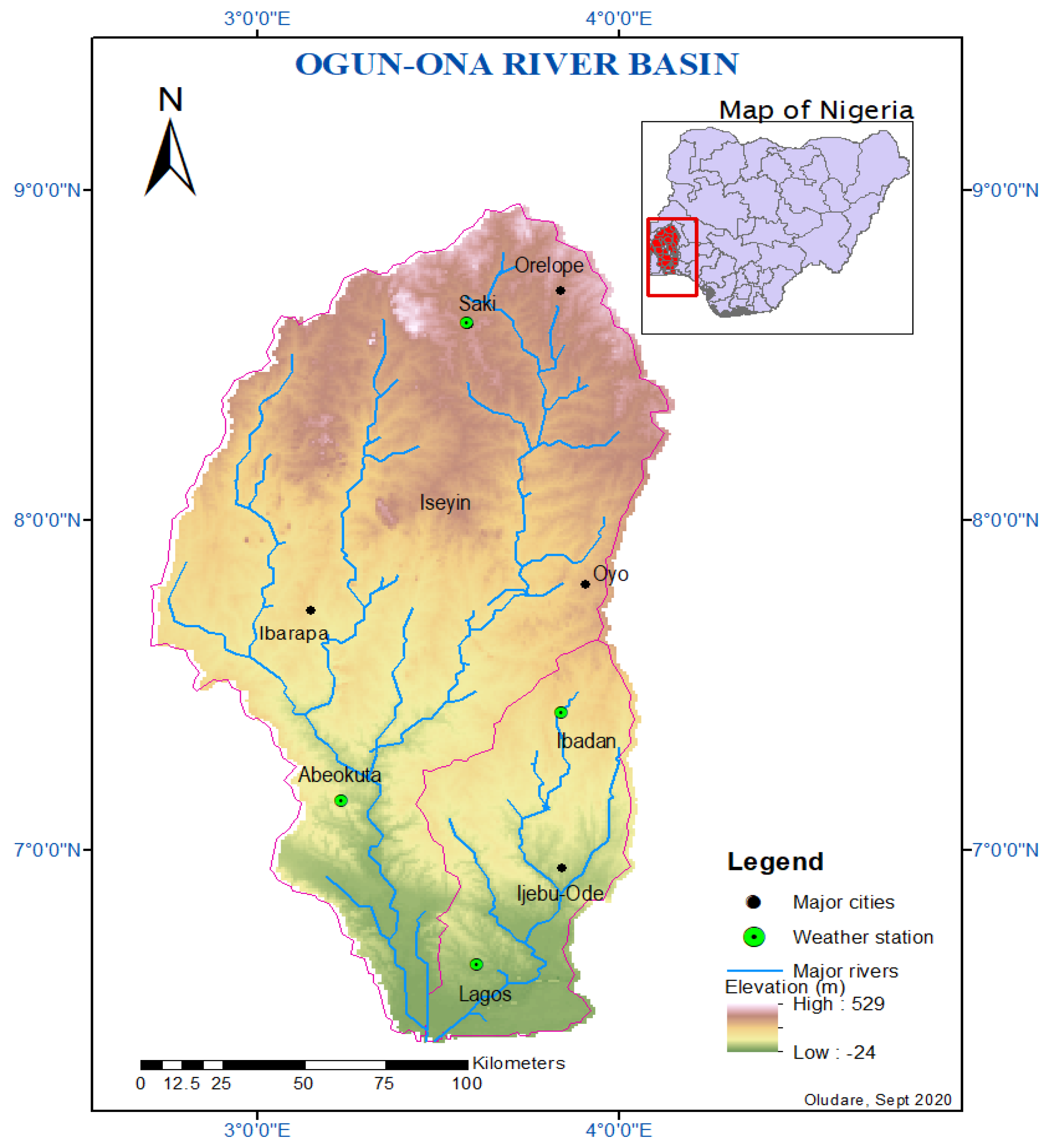
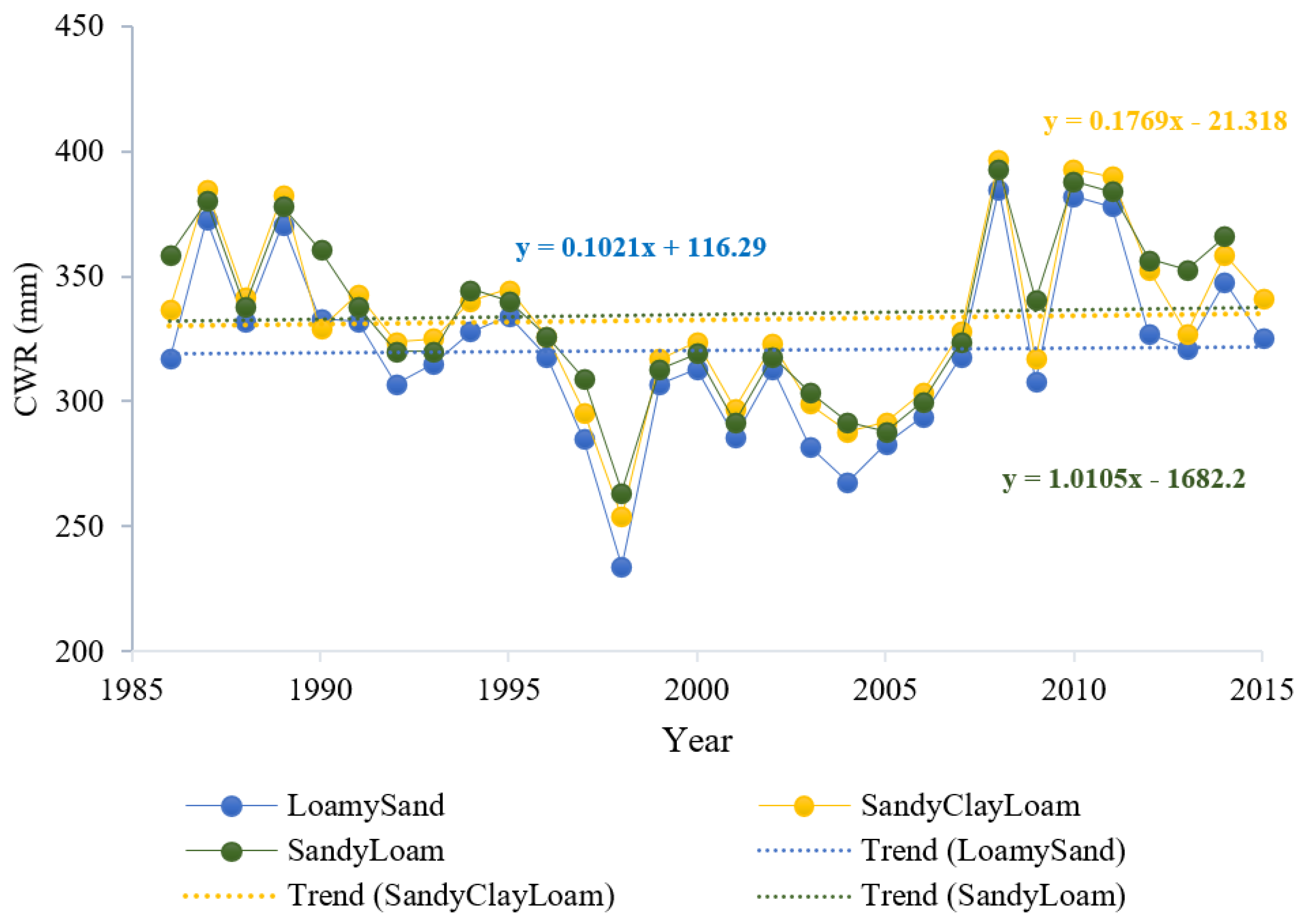
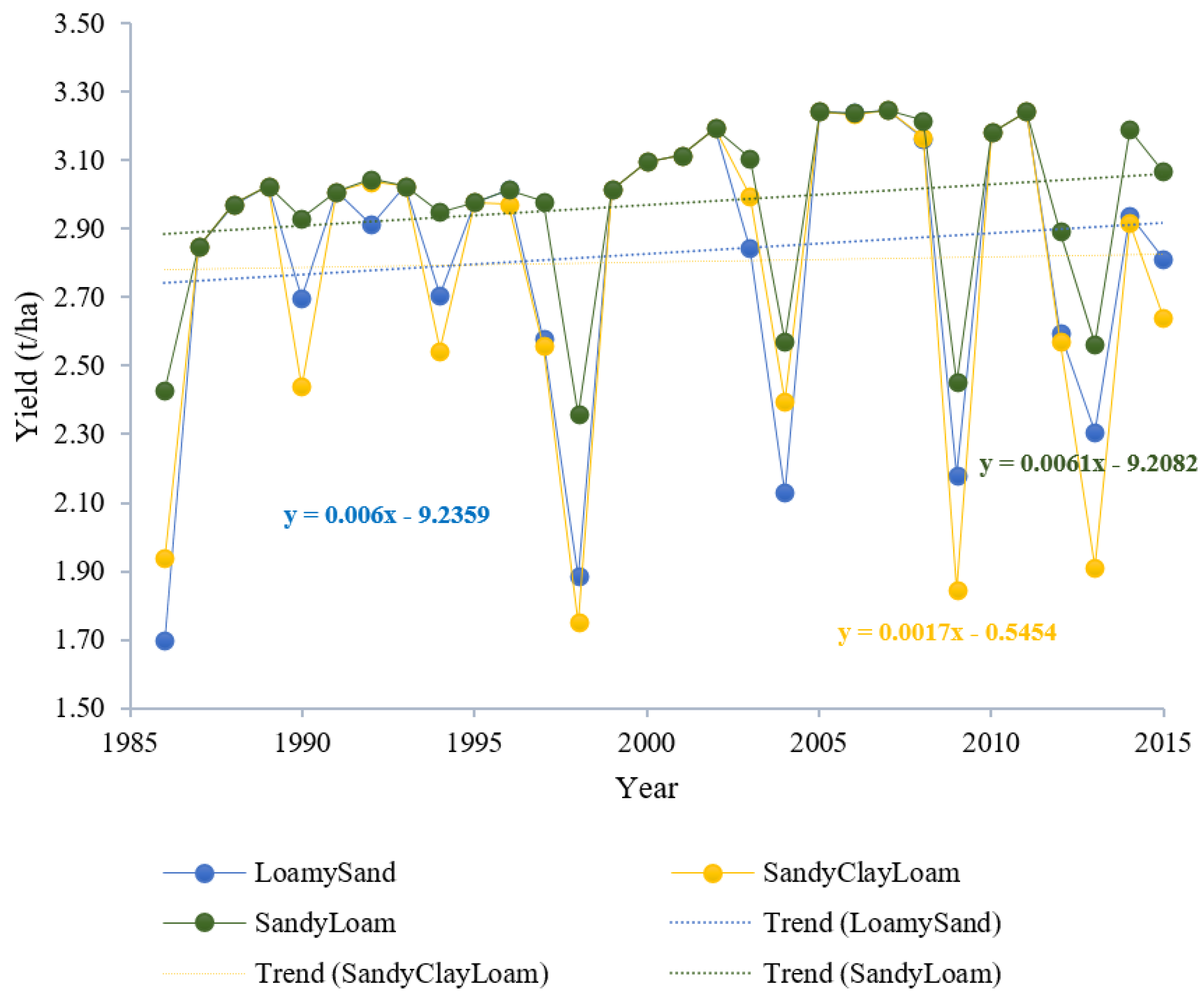
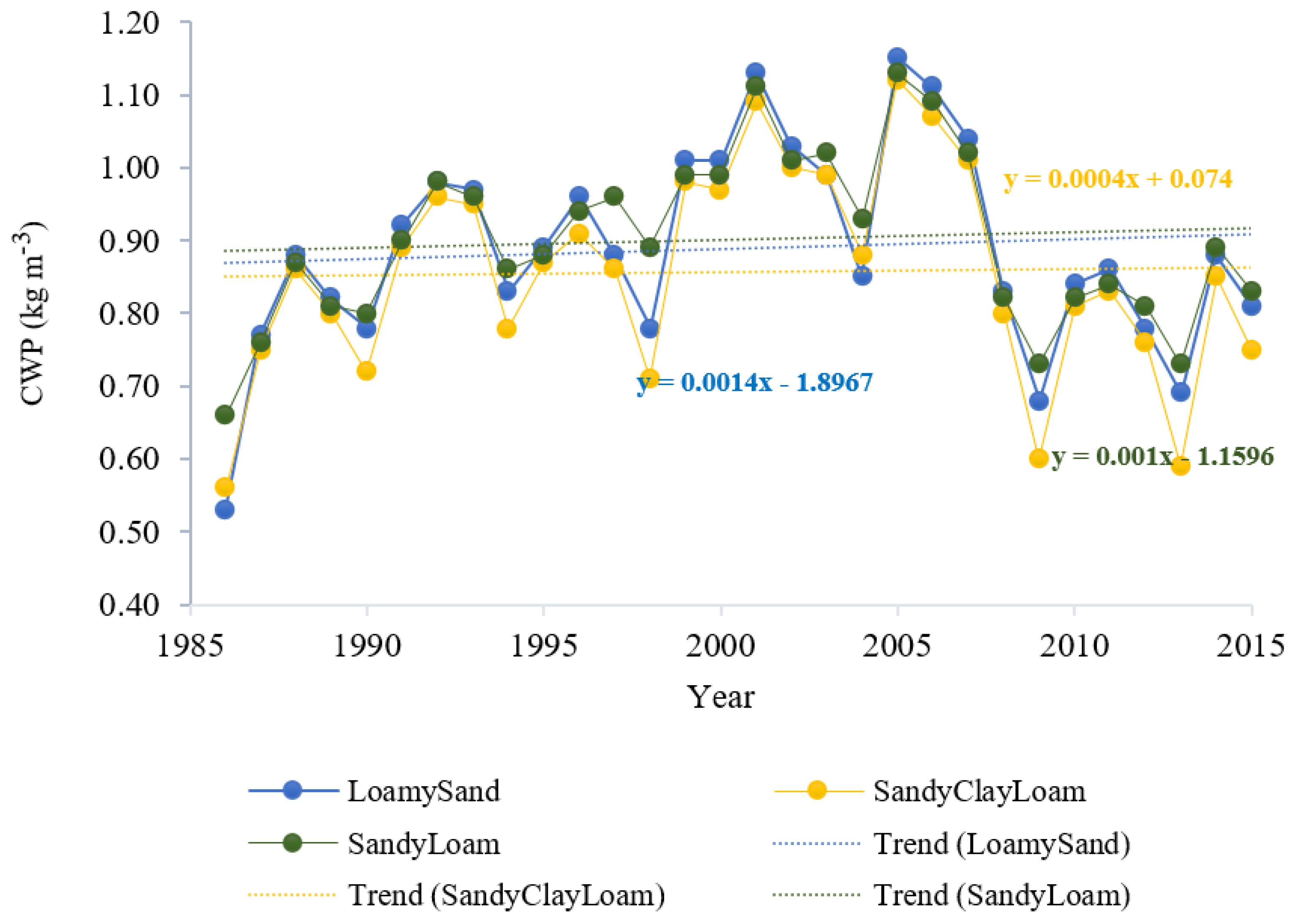
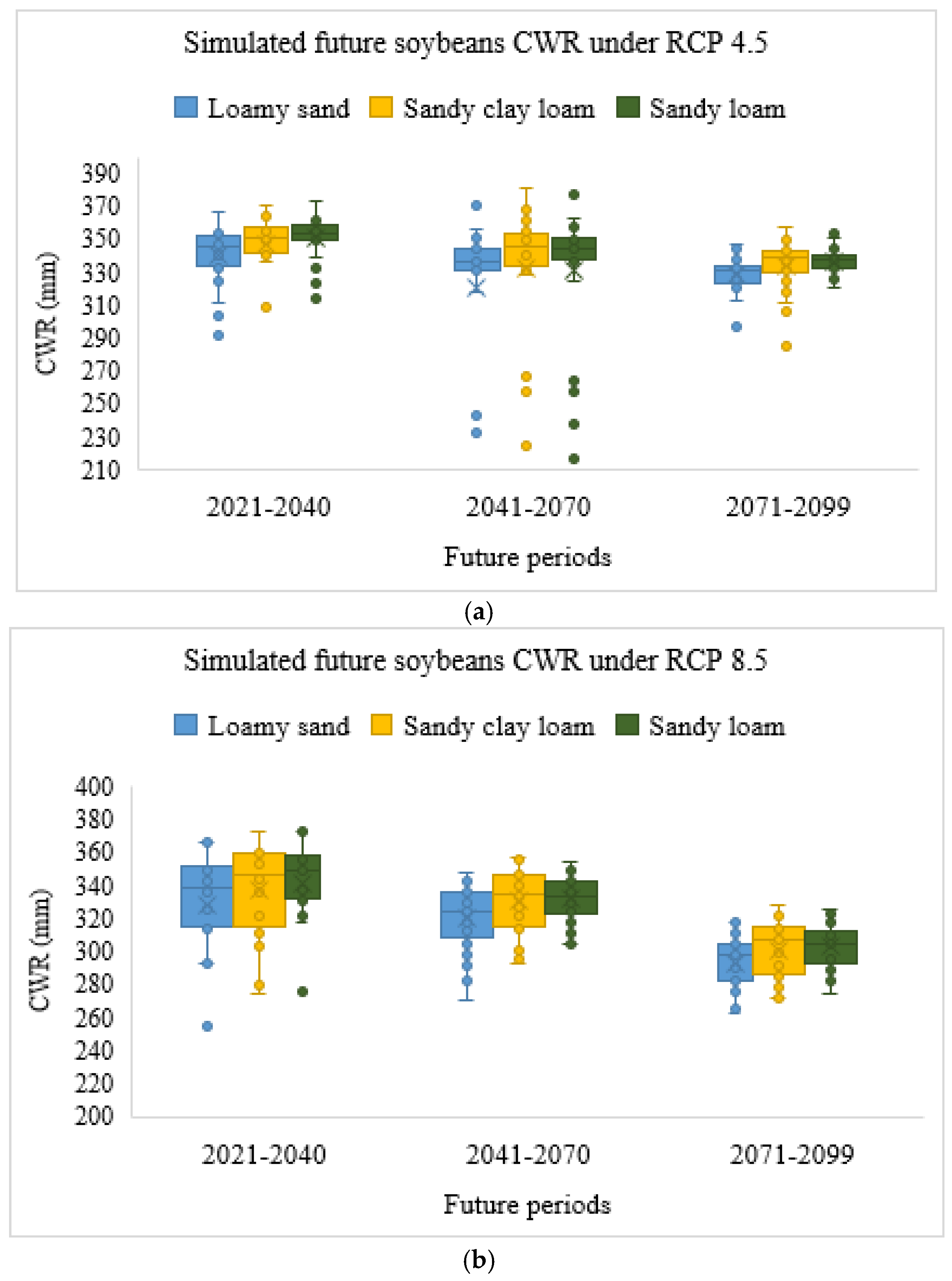
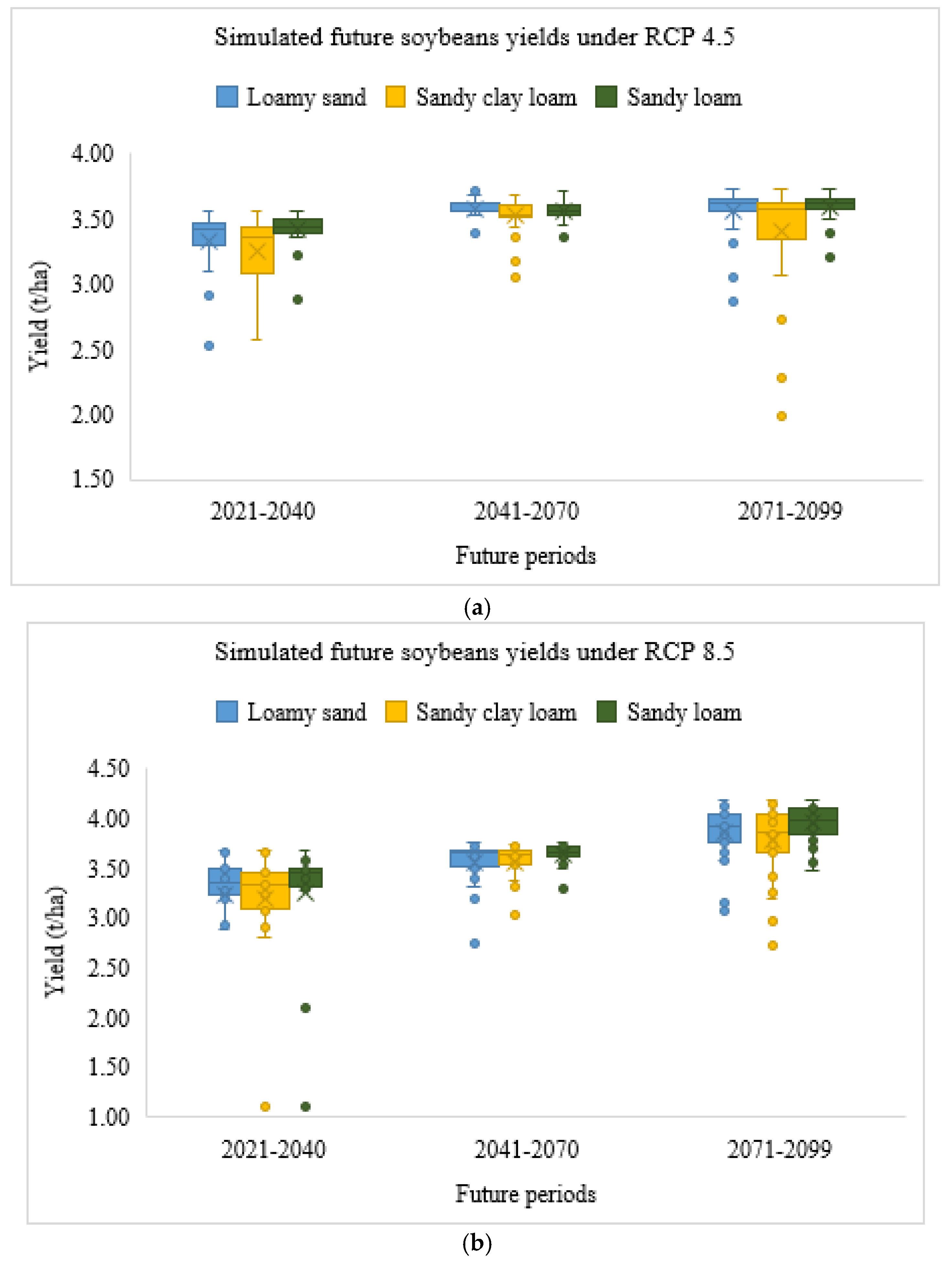
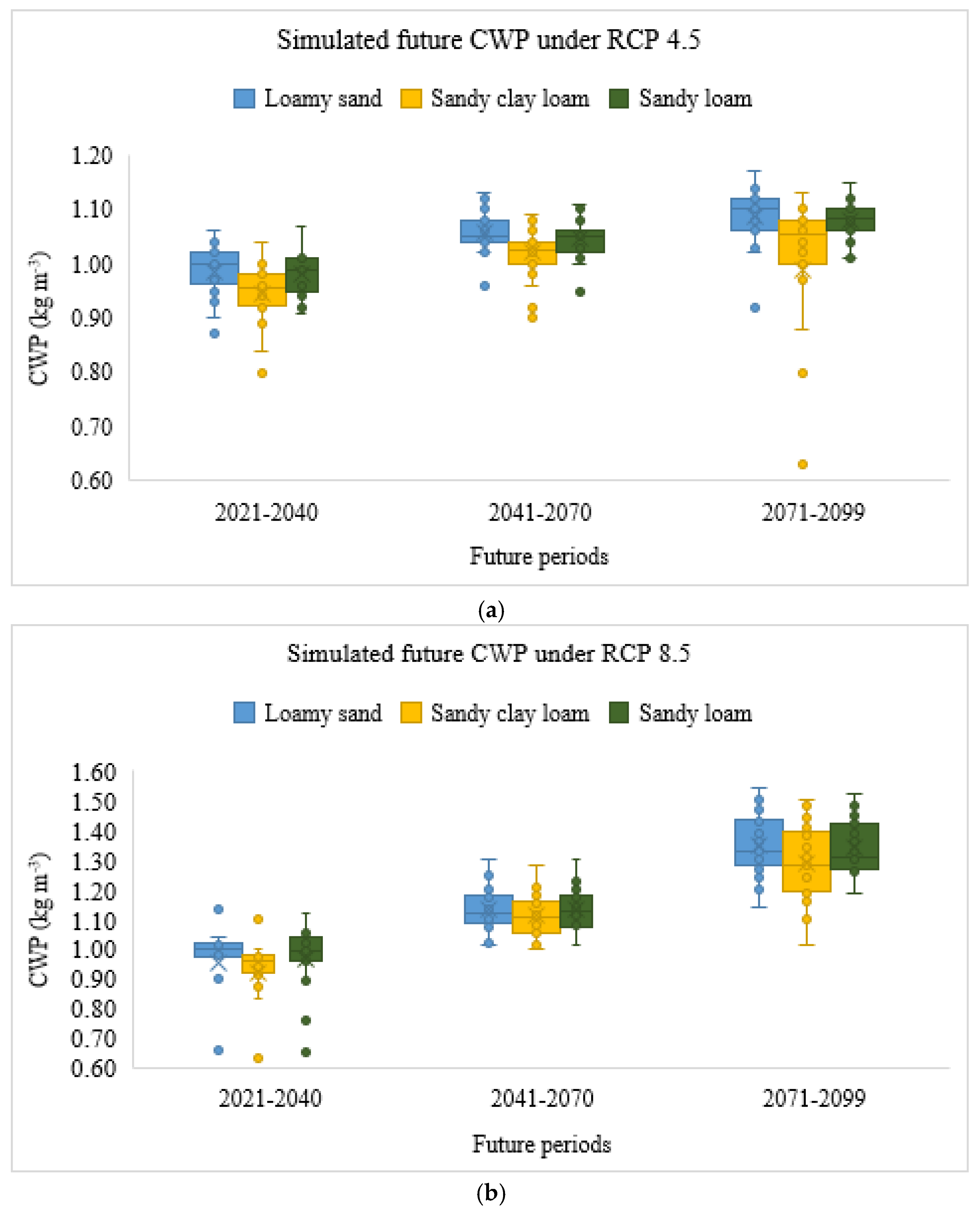
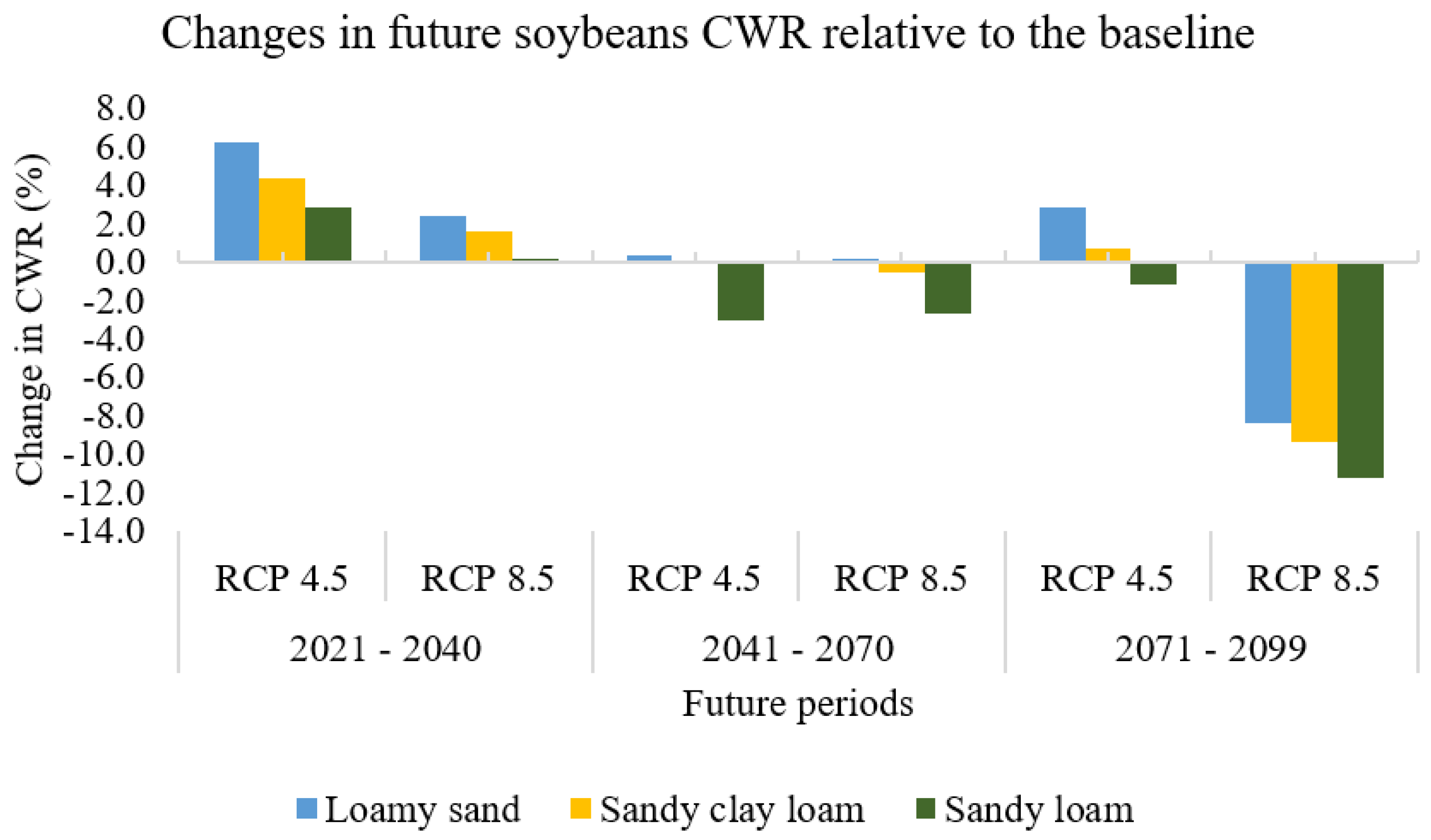
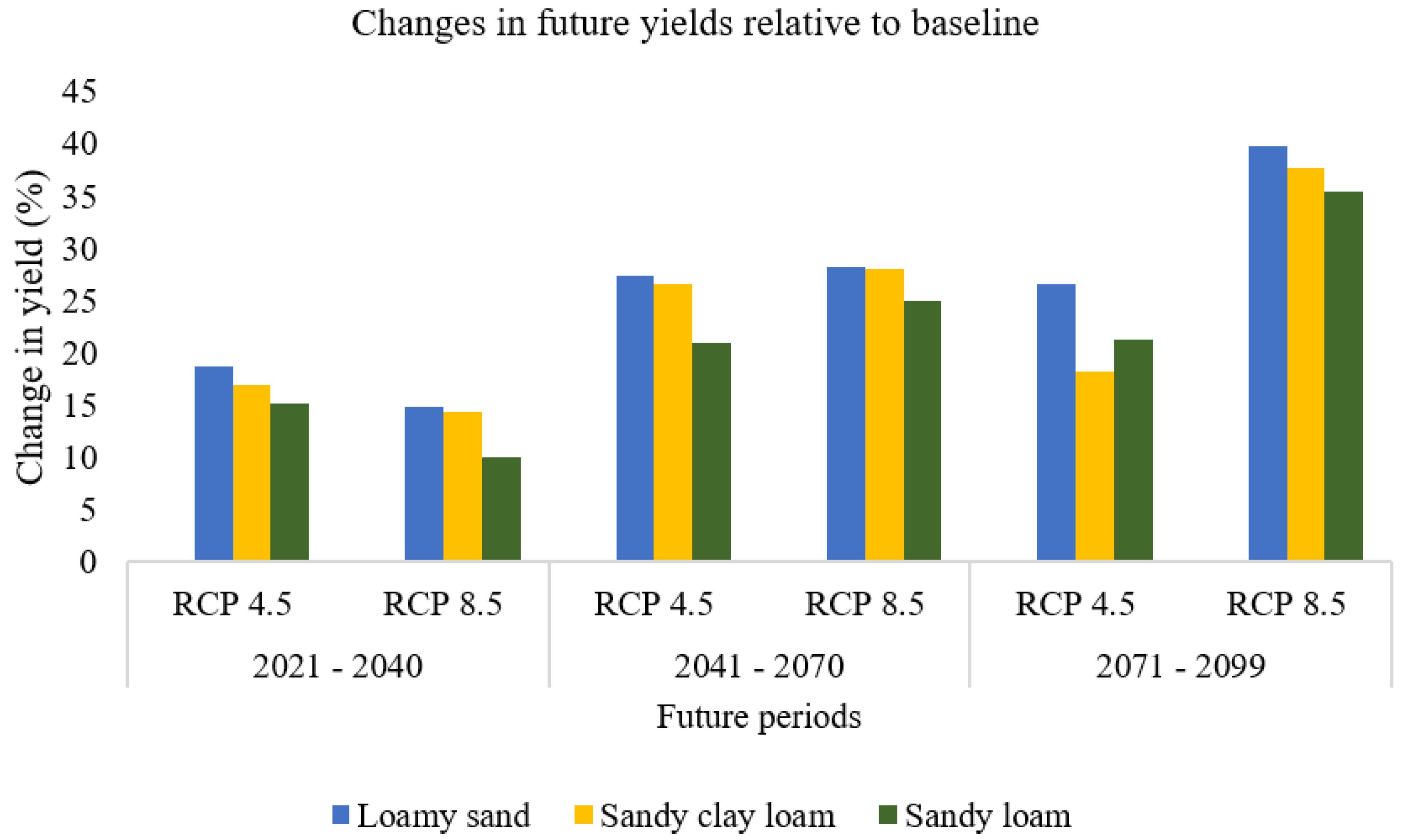

| Soil Texture (0–100 cm) | PWP | FC | SAT | TAW | Ksat |
|---|---|---|---|---|---|
| (vol. %) | (vol. %) | (vol. %) | (mm/m) | (mm/Day) | |
| Loamy sand | 8.0 | 14.0 | 46.0 | 60.0 | 1560.0 |
| Sandy clay loam | 17.7 | 27.5 | 43.0 | 98.0 | 214.0 |
| Sandy loam | 11.5 | 19.0 | 43.3 | 75.0 | 804.4 |
| Statistical Parameters | R2 | RMSE (mm) | MAE (mm) | NSE |
|---|---|---|---|---|
| Rainfall (before bias correction) | 0.54 | 3.27 | 2.25 | −0.11 |
| Rainfall (after bias correction) | 0.75 | 0.52 | 0.43 | 0.76 |
| Minimum temperature | 0.84 | 0.92 | 0.72 | 0.74 |
| Maximum temperature | 0.85 | 0.89 | 0.68 | 0.75 |
| Climatic Parameters | Baseline (1986–2015) | Relative Changes | |||||
|---|---|---|---|---|---|---|---|
| RCP 4.5 | RCP 8.5 | ||||||
| 2021–2040 | 2041–2070 | 2071–2099 | 2020–2040 | 2041–2070 | 2071–2099 | ||
| Rainfall (mm) | 1340 | −140 (−10.4%) | 45 (3.4%) | −110 (−8.2%) | −130 (−9.7%) | −110 (−8.2%) | −130 (−9.7%) |
| Minimum temperature (°C) | 22.3 | 0.9 (4.0%) | 1.4 (6.3%) | 2.4 (10.8%) | 1.4 (6.3%) | 2.4 (10.8%) | 4.2 (18.4%) |
| Maximum temperature (°C) | 31.6 | 1.2 (3.8%) | 1.9 (6.1%) | 2.7 (8.5%) | 1.5 (4.8%) | 2.8 (8.9%) | 4.4 (13.9%) |
Publisher’s Note: MDPI stays neutral with regard to jurisdictional claims in published maps and institutional affiliations. |
© 2020 by the authors. Licensee MDPI, Basel, Switzerland. This article is an open access article distributed under the terms and conditions of the Creative Commons Attribution (CC BY) license (http://creativecommons.org/licenses/by/4.0/).
Share and Cite
Durodola, O.S.; Mourad, K.A. Modelling the Impacts of Climate Change on Soybeans Water Use and Yields in Ogun-Ona River Basin, Nigeria. Agriculture 2020, 10, 593. https://doi.org/10.3390/agriculture10120593
Durodola OS, Mourad KA. Modelling the Impacts of Climate Change on Soybeans Water Use and Yields in Ogun-Ona River Basin, Nigeria. Agriculture. 2020; 10(12):593. https://doi.org/10.3390/agriculture10120593
Chicago/Turabian StyleDurodola, Oludare Sunday, and Khaldoon A. Mourad. 2020. "Modelling the Impacts of Climate Change on Soybeans Water Use and Yields in Ogun-Ona River Basin, Nigeria" Agriculture 10, no. 12: 593. https://doi.org/10.3390/agriculture10120593
APA StyleDurodola, O. S., & Mourad, K. A. (2020). Modelling the Impacts of Climate Change on Soybeans Water Use and Yields in Ogun-Ona River Basin, Nigeria. Agriculture, 10(12), 593. https://doi.org/10.3390/agriculture10120593






